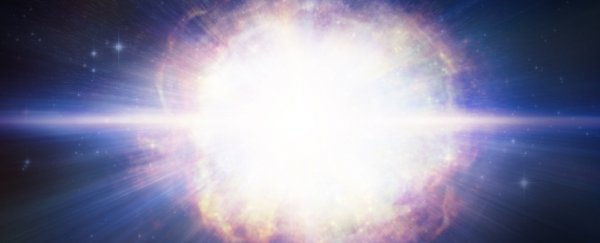Massive stars don't die quietly. Their deaths are spectacular explosions that can outshine entire galaxies - and now, astronomers have identified the most powerful of these exploding stars we've ever witnessed.
The supernova, named SN2016aps, was observed by the PanSTARRS Survey for Transients on 22 February 2016, in a galaxy 4.5 billion light-years from Earth.
Now, astronomers have determined that SN2016aps was 500 times brighter than typical supernova explosions. It is, they say, the brightest, most energetic and maybe even the most massive supernova we've ever seen - pushing it towards the category of hypernova.
"SN2016aps is spectacular in several ways," explained astronomer Edo Berger of Harvard University. "Not only is it brighter than any other supernova we've ever seen, but it has several properties and features that make it rare in comparison to other explosions of stars in the Universe."
Although it peaked in January 2016, observations of SN2016aps were not limited to that timeframe. After the supernova was spotted in the PanSTARRS data, astronomers kept a careful eye to observe how the object dimmed over time, a process that's still occurring.
They also looked into data obtained before that January 2016 peak, and saw that SN2016aps had been brightening in the weeks prior to the big kaboom, dating back to December 2015.
The total kinetic energy of SN2016aps was around 5×1052 erg, putting it about on a par with the famous 1998 hypernova SN1998bw, from a progenitor star 25 to 40 times the mass of the Sun. But the peak luminosity of SN2016aps was 4.3×1044 erg, over 40 times brighter than SN1998bw's 1×1043-erg peak luminosity.
"The intense energy output of this supernova pointed to an incredibly massive star progenitor," Berger said. "At birth, this star was at least 100 times the mass of our Sun."
Even so, it's unlikely that this star could have produced such a colossal explosion on its own. In fact, there's something really peculiar about it, as spectroscopic observations of the supernova revealed.
"We determined that in the final years before it exploded, the star shed a massive shell of gas as it violently pulsated," said astronomer Matt Nicholl of the University of Birmingham. "The collision of the explosion debris with this massive shell led to the incredible brightness of the supernova. It essentially added fuel to the fire."
Although it's normal for dying stars to shed mass, it's not usual for a star to shed that much mass in such a short timeframe, so soon before exploding. Research on how and why this happened will need to be undertaken with simulations and modelling.
The researchers also found high levels of hydrogen, which was puzzling, because massive stars usually eject most of their hydrogen before going supernova. But this puzzle has an answer: the one big star was once two smaller stars that merged.
"That SN2016aps held onto its hydrogen prompted us to theorise that two less massive stars had merged together, since lower mass stars hold onto their hydrogen for longer," Berger said.
The mass and hydrogen abundance of this merged progenitor star could place SN2016aps as a rare type of supernova only seen in very massive stars rich in hydrogen and helium called a pulsational pair-instability supernova.
This is an event that looks like a very bright supernova, but only part of the star's mass is blown off into space, leaving behind a lower-mass star that will eventually undergo a real supernova.
A lower likelihood, but still a possibility, is a full pair-instability supernova. This is when the core of a massive star is so hot, it produces electron-positron pairs, reducing the radiation pressure that keeps the star from collapsing. This results in a runaway nuclear explosion that blows the star completely apart, without even leaving a core remnant.
We don't yet know which of these SN2016aps was. Detailed simulations will need to be conducted to help figure it out.
But now that SN2016aps has been identified, we'll be able to search for more events like it. And that, too, can help us characterise these incredible explosions.
"The identification of SN2016aps has opened pathways to identifying similar events from the first generations of stars," Berger said.
"With the upcoming Large Synoptic Survey Telescope we can find such explosions from the first billion years in the history of the universe, and there will be plenty of examples then."
The research has been published in Nature Astronomy.
